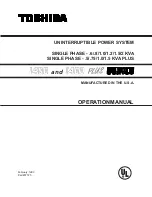
6
times) can silence the buzzer. Press the button for more than 5 seconds (buzzer beeps twice) again to resume the alarm function.
c) LCD display screen switch
Pressing the function button for more than 1 seconds (buzzer beeps once) to switch LCD display screen.
4. LED indicators
The LED indicators contains Fault indicator, Bypass indicator, utility power indicator, Inverter indicator, Battery indicator. The definition of
each indicator is the same as LED panel (refer to table Appendix 1).
4.2
Operation mode
UPS operation mode contains normal mode, battery mode and bypass mode. Under the three modes, the page showing output voltage and
output frequency is the main display page. If users need more information about UPS, Pressing the function button can initiate display
screen switch. If the current page is not the main page, UPS will auto switch back the main page after 30 seconds. In order to extend the LCD
usage life, the backlight will turn off after 1 minute without any switch operation. At this point, Users just need to touch any button briefly,
the backlight will be turn on.
4.2.1 Normal mode
When operating in the normal mode, the display of main page on the front panel is shown as the figure 4-2. The utility power indicator and
the Inverter indicator are turn on. Load information area shows load value, and the battery level area indicates dynamically when the battery
is not full charged (the battery level icons lit one after another circularly). When the battery is full charged, all the level icons are turn on.
1) If the utility power indicator blinks, it indicates that there are problems with reversed polarity (L, N) of site wiring or disconnect with
ground. UPS is still working in normal mode. If the battery indicator is turn on at the same time, it shows that the voltage or frequency of
the utility power is out of the normal input range of the UPS. The UPS works in battery mode.
Figure 4-2 Normal Mode
2) If load is more than 105 percent, the buzzer beeps twice every second, meanwhile, the warning icon blinks every second too, reminding
that you have been overloaded. You should get rid of some unnecessary loads one by one to decrease the loads until the alarm clear.
3) If the battery indicator blinks, it indicates that no battery is connected to the UPS or battery voltage is too low. You should check if battery
is properly connected to the UPS, and press function button more than 5 seconds to start the battery self-diagnosis. If the connection
between battery and UPS is confirmed without any problem, it may be due to the defect or aging of the battery, please refer to the
“troubleshooting” in chapter 7 to solve the problem accordingly.
4) The other four display pages are load percent page, actual load page, input information page and the maximum temperature page.
Note
:
Connection to the power generator should be made according to the following steps:
Activate the power generator and wait until the operation is stable before connecting the output of the power generator to the UPS (be sure that
the UPS is in idle mode). Then, turn on the UPS according to the startup procedure. After the UPS is turned on, the loads are connected one by
one.
It recommended that the capacity of the AC generator chosen should double that of the UPS.
4.2.2 Battery mode
When operating in the normal mode, the display of main page on the front panel is shown as the figure 4-3. The battery indicator and the
Inverter indicator are turn on. If the utility power indicator blinks at the same time, it shows that the utility power is abnormal. Load
information area shows load value, and bat level area shows current battery capacity.
1) When the UPS is running in battery mode, the alarm will beep every 4 seconds. If the “Function” key is pressed for more th
an 5 seconds,
the alarm will not beep (silence function)
. Press the “Function” key more than
5 seconds again to resume the alarm function.








































